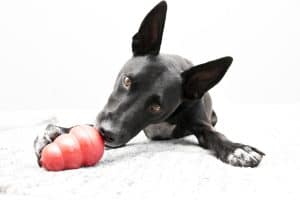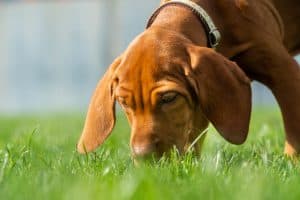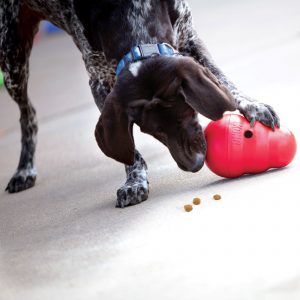
The Importance of Sniffing
Why dogs sniff & how it can help with training
Did you know you can get the behavior and training results you desire, through the power that is hidden behind your dog’s cute little nose?
Behind a dog’s nose lies a built-in super sniffer highway, and an infinity and beyond sense of smell that is woven into their anatomy and DNA. These two powers (sniffing and smelling) enable them to learn, gather information, socially interact and communicate through chemical compounds (pee-mail), make decisions, and interpret the world around them.
With over 220 million olfactory receptors residing within their super sniffers, they can recognize scents from the largest of animals to the smallest of organisms: on, below, or above the ground. They can detect with great sensitivity the scent of emotions, stress levels, hormones, and disease processes. Their noses save lives in detecting landmines, drug, and biological warfare, search and rescue efforts, and many other service-related tasks for humans. That said, there are factors that can affect the ability your dog has to sniff and smell such as genetics, age, breed, health, environment, temperature, humidity, wind, and weather conditions.
There are many traffic signals and roads within a dog’s super sniffer highway, so let’s go on a trip starting at the tip of their nose. 
Dogs have two main anatomical destinations for detecting and processing odors: The MOE (Main Olfactory Epithelium) and the VNO (Vomeronasal or Jacobson’s Organ). The inhaled air travels along two roads: The upper road goes straight to the MOE, where odor molecules are deposited. The remainder of the inhaled air goes to a lower road that leads to the pharynx and lungs. These roads and their ability to use each nostril independently, allow dogs to breathe, smell, sample and compare inhaled air all at the same time. They use the right nostril when they start to sniff and continue using it, if the smell is new, threatening or adrenaline-producing. They shift gears and use the left nostril when presented with familiar stimuli. When the right nostril is driving, it lights up the road leading into the right hemisphere of the brain that controls processing of new information. When the left nostril is driving, it lights up the road leading to the left hemisphere of the brain that is in charge of behavior responses to familiar stimuli. If the stimuli continue to be threatening or adrenaline-producing, the right side of the nostril and roadway remain lit.
Now that we have taken a short drive through their anatomy, let’s take a turn to the fascinating role sniffing plays in influencing their behavior, health, and wellbeing.
Every time your dog sniffs, it engages the “Seeking” system within their brain. When this system is activated, the brain makes and releases a powerful neurotransmitter called dopamine, also known as the happy hormone. When dopamine is released, it helps increase a dog’s learning, movement, memory, and overall cognition and pleasure.
By providing short, systematic sniffing opportunities we can meet their critical needs for enrichment, physical, and mental exercise. The best part is that when they are sniffing all needs are met at the same time! What a great deal that pays off in their overall behavior and wellness.
Just like money is an important reinforcer for humans, one of our dog’s primary reinforcers is food. Although dogs can find other things reinforcing such as toys, praise, petting, and play, most of the latter aren’t high enough in value or are hard to use to build a solid training foundation. Depending on the dog, you will find many things on that list aren’t reinforcing at all, but what about sniffing?
When used properly, the opportunity to sniff can become as powerful, if not more, of a reinforcer than food. In my own training, as well as the Behavior Modification Specialty Course I lead with clients, I teach systematic sniffing exercises to help dogs overcome their environmental triggers.
 Training your dog to sniff on cue.
Training your dog to sniff on cue.
In my training, I frequently use sniffing to reinforce and strengthen many behaviors, including walking on a loose leash. To achieve this, dogs must first learn to sniff on cue. The first step is to choose a proper training location. Sidewalks are not a good option as the grass is too close, and they can easily access it and other sniff spots before you are ready to cue sniffing. This will quickly derail the training. Instead, train in the middle of your driveway or go to an empty parking lot where you can get enough distance away from the sniff spots, so the dog isn’t pulling on the leash.
Once in your chosen location, simply stand at the appropriate distance from something you know they will want to sniff, like the grass, a trashcan, or a tree. Next, say the verbal cue “Go sniff”, pause, and let slack out of the leash accordingly as you accompany your dog to the sniff spot, and their natural instincts will take it from there. Now, your job is to stand still and observe them closely. As they begin to raise their head from sniffing, say their walking cue “Let’s go!”. Then give them a treat every few feet, as you walk away and back out to the same area you started from.
Keep in mind, it’s very important not to interrupt your dog mid-sniff, as they are in the middle of communicating and gathering information. It would be similar to you speaking and someone cutting you off mid-sentence; you would find that aversive and so do they.
However, too much sniffing can send their super sniffers into overdrive on that highway, and you will end up losing their focus to train during the session. Your sessions should be a thoughtful, deliberate, short dance back and forth between well-known cues and the “Go sniff” cue, to keep it balanced and fun for both sides of the leash.
Speaking of fun, that is how our dogs feel when they are foraging for food! It engages their “Seeking” system, and KONG has several thoughtfully designed products that will kick that system right into gear.
A couple of my favorites are KONG Classic rubber toys, Goodie Bones, Goodie Ribbon, the Wobbler, and Rewards toys. All you have to do is fill them with their own dog food, safe human food(s), and/or treats (find some fun KONG recipes here!). Then say “Find-it”, pause, and place the toy down, and they will take the toy. After practicing “Find it” with the toy nearby for a while, you can begin to hide the KONG around your home in increasingly distant and challenging spots. After all, dogs were designed to hunt for their food!
To play “Find it” outside, you can hide the KONG or Goodie Bone, or sprinkle dog food in your yard ahead of time. Then send your dog out on a sniffing adventure! They will love it and you will love the behavioral benefits of an exercised body and mind.
SO, GO AND GET YOUR SNIFF ON!
 from Tara Fisher, RVT, CPDT KA, KPA CTP, FFCP
from Tara Fisher, RVT, CPDT KA, KPA CTP, FFCP




